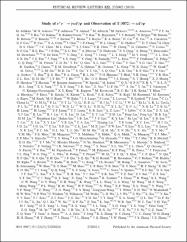Study of e(+)e(-) -> gamma omega J/psi and Observation of X(3872) -> omega J/psi

View/
Access
info:eu-repo/semantics/openAccessAttribution 3.0 United Stateshttp://creativecommons.org/licenses/by/3.0/us/Date
2019Metadata
Show full item recordCitation
Ablikim, M., Achasov, M. N., Adlarson, P., Ahmed, S., Albrecht, M., Alekseev, M., . . . Collaboration, B. (2019). Study of e(+)e(-) -> gamma omega J/psi and Observation of X(3872) -> omega J/psi. Physical Review Letters, 122(23), 8. doi:10.1103/PhysRevLett.122.232002Abstract
We study the e(+)e(-) -> gamma omega J/psi process using 11.6 fb(-1) e(+)e(-) annihilation data taken at center-of-mass energies from root s = 4.008 GeV to 4.600 GeV with the BESIII detector at the BEPCII storage ring. The X(3872) resonance is observed for the first time in the omega J/psi system with a significance of more than 5 sigma. The relative decay ratio of X(3872) -> omega J/psi and pi(+)pi(-)J/psi is measured to be R = 1.6(-0.3)(+0.4) +/- 0.2, where the first uncertainty is statistical and the second systematic (the same hereafter). The root s-dependent cross section of e(+)e(-) -> gamma X(3872) is also measured and investigated, and it can be described by a single Breit- Wigner resonance, referred to as the Y(4200), with a mass of 4200.6(-13.3)(+7.9) +/- 3.0 MeV/c(2) and a width of 115(-26)(+38) +/- 12 MeV. In addition, to describe the omega J/psi mass distribution above 3.9 GeV/c(2), we need at least one additional Breit-Wigner resonance, labeled as X(3915), in the fit. The mass and width of the X(3915) are determined. The resonant parameters of the X(3915) agree with those of the Y(3940) in B -> K omega J/psi and of the X(3915) in gamma gamma -> omega J/psi observed by the Belle and BABAR experiments within errors.
Source
Physical Review LettersVolume
122Issue
23Collections
The following license files are associated with this item:


















